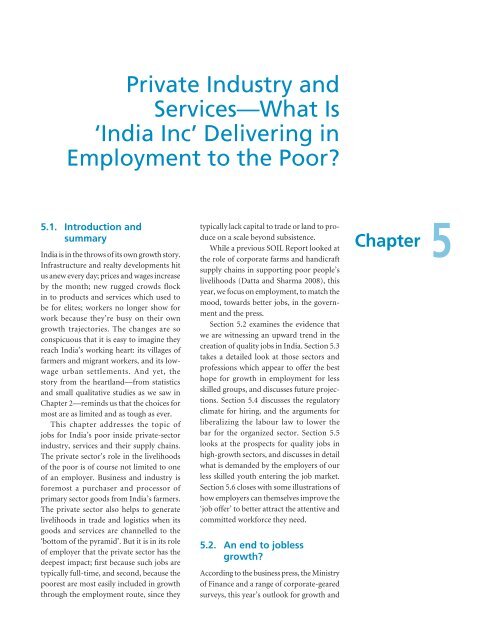Private Industry and<strong>Services</strong>—What Is‘India Inc’ Delivering inEmployment to the Poor?5.1. Introduction andsummaryIndia is in the throws of its own growth story.Infrastructure and realty developments hitus anew every day; prices and wages increaseby the month; new rugged crowds flockin to products and services which used tobe for elites; workers no longer show forwork because they’re busy on their owngrowth trajectories. The changes are soconspicuous that it is easy to imagine theyreach India’s working heart: its villages offarmers and migrant workers, and its lowwageurban settlements. And yet, thestory from the heartland—from statisticsand small qualitative studies as we saw inChapter 2—reminds us that the choices formost are as limited and as tough as ever.This chapter addresses the topic ofjobs for India’s poor inside private-sectorindustry, services and their supply chains.The private sector’s role in the livelihoodsof the poor is of course not limited to oneof an employer. Business and industry isforemost a purchaser and processor ofprimary sector goods from India’s farmers.The private sector also helps to generatelivelihoods in trade and logistics when itsgoods and services are channelled to the‘bottom of the pyramid’. But it is in its roleof employer that the private sector has thedeepest impact; first because such jobs aretypically full-time, and second, because thepoorest are most easily included in growththrough the employment route, since theytypically lack capital to trade or land to produceon a scale beyond subsistence.While a previous <strong>SOIL</strong> <strong>Report</strong> looked atthe role of corporate farms and handicraftsupply chains in supporting poor people’slivelihoods (Datta and Sharma 2008), thisyear, we focus on employment, to match themood, towards better jobs, in the governmentand the press.Section 5.2 examines the evidence thatwe are witnessing an upward trend in thecreation of quality jobs in India. Section 5.3takes a detailed look at those sectors andprofessions which appear to offer the besthope for growth in employment for lessskilled groups, and discusses future projections.Section 5.4 discusses the regulatoryclimate for hiring, and the arguments forliberalizing the labour law to lower thebar for the organized sector. Section 5.5looks at the prospects for quality jobs inhigh-growth sectors, and discusses in detailwhat is demanded by the employers of ourless skilled youth entering the job market.Section 5.6 closes with some illustrations ofhow employers can themselves improve the‘job offer’ to better attract the attentive andcommitted workforce they need.5.2. An end to joblessgrowth?According to the business press, the Ministryof Finance and a range of corporate-gearedsurveys, this year’s outlook for growth andChapter5
110 State of India’s Livelihoods <strong>Report</strong> <strong>2011</strong>job creation across sectors is good. TheEconomic Survey reports that growth inthe industrial sector will be ‘moderate butsustainable’ while it continues to remainstagnant as a percentage of GDP (now at20.5 per cent). This is in marked contrastto the service sector which is now at65 per cent of GDP (2009–10). The dominantinformation technology and ITESsector bounced back from the global crisissurprisingly rapidly and posted a growth of19 per cent between 2009–10 and 2010–11.‘Even during the crisis year’, concludes theEconomic Survey:…annual services growth was around the10 per cent mark, which it has maintainedsince 2005–6. This is in contrast to the overallGDP growth which fell to 6.8 per cent in2008–9 from 9.3 per cent in 2007–8. Thusthe resilience of the services sector has greatlycontributed to the resilience of the economy.(Economic Survey <strong>2011</strong>)Bank and non-bank credit is now flowingwell in spite of the RBI’s rounds ofmonetary tightening and increased interestrates, while FDI is still affected by the globalslowdown, hurting the industry more thanthe key services (financial, telecoms, ITESand real estate).The Labour Bureau’s quick quarterlysurveys—tracking global recession-affectedindustries—show that employment, whileit shrunk in all tracked sectors in the threequarters of the late 2008 to mid-2009, hasrecovered in most sectors since then. Textilesand apparel (especially handloom andpower loom sectors), leather and gems andjewellery remain shaky and are still reportingnegative employment. Meanwhile, highgrowthservice sectors are inching towardsexports, and to less developed northern andeastern states. While GDP growth estimatesfor <strong>2011</strong>–12 have been revised down, theystill stand at just below 8 per cent.Other than an upbeat forecast for corporategrowth, and some evidence of recoveryof labour-intensive sectors since 2009, whatis the prognosis for creation of jobs? Thequestion pertains not to subsistence levelself-employment or poorly waged work inthe unorganized sector, but to jobs withgood wages and prospects in the organizedsector.Several recent articles (Gupta et al.2009; Nagaraj <strong>2011</strong>; Goldar <strong>2011</strong>a, <strong>2011</strong>b)debate the meaning of the evidence thatemployment in the organized manufacturingindustry shows a sharp growth since2003–04. Reversing a long-term trend oflow growth, maybe even shrinking employment,the figures from the Annual Survey ofIndustries (ASI) show an astounding annualgrowth of 7.5 per cent between 2003–04 and2008–09. Goldar compares this figure totrends since 1980, looking at annual growthin value-addition alongside employment(see Table 5.1).Goldar remarks that the employmentgrowth between 2003–04 and 2008–09 hasbeen fastest in those industries that areincorporated as private limited companies,in which the rate of employment increasedat 14 per cent a year. 1 He further argues thatemployment growth has been faster in theless labour-intensive industries, highlightingthat the average or low ‘labour intensity’Table 5.1: Trends in employment and value-addition in organized manufacturing1980–81 to1989–901992–2003 to1996–20071995–2006 to2003–042003–04 to2008–09Growth in employment (annual per cent) 0.3 2.8 –1.5 7.5Growth in value-addition (annual per cent) 8.6 13 n.a. 10Source: Goldar <strong>2011</strong>a, from ASI figures.1The proportion of companies registered as privatelimited also increased in the period, from 25 per cent ofthe ASI sample in 2003–04 to 33 per cent in 2008–09.














